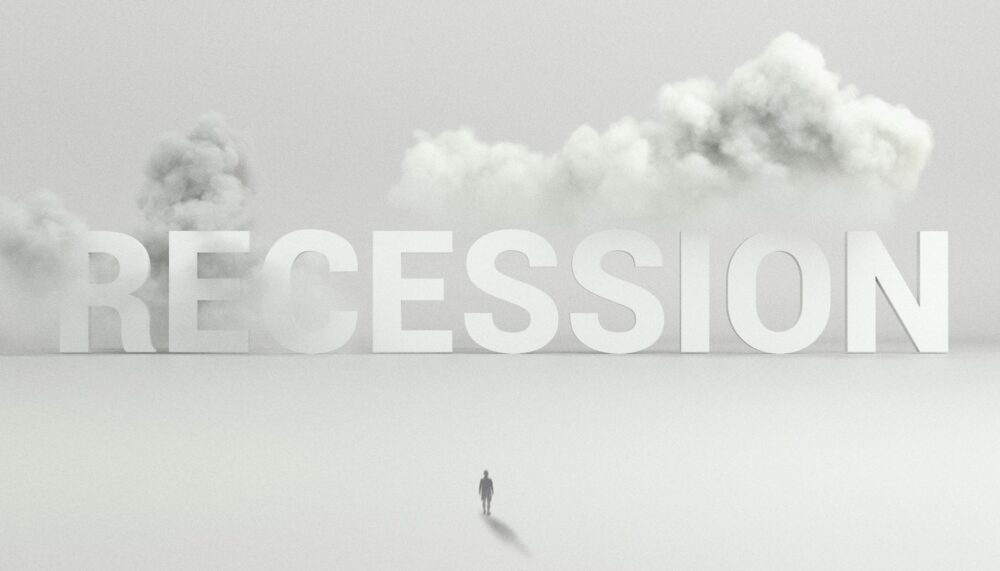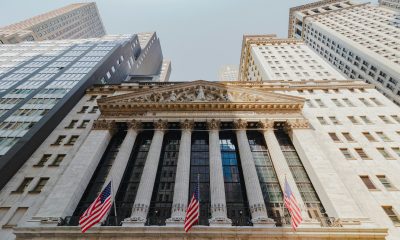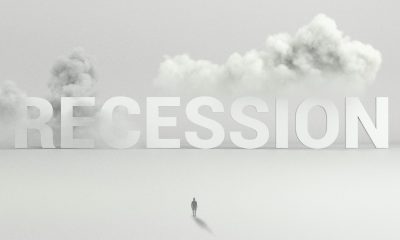Business
Recession Now or Stagflation Forever: Labor Market Is Weakening
The U.S. labor market shows signs of slowing, with fewer net new jobs, rising layoffs, and weaker hiring plans. Despite this, the Fed hints at rate cuts to support asset prices and prevent economic fallout. Inflation remains a significant concern, threatening middle-class livelihoods and suggesting that further economic pain, possibly through a recession, is inevitable.

The labor market is clearly weakening. But in reality, this is what needs to happen. Recession, a short-term pain is needed to reconcile the great imbalances created by decades of free money. The alternative is intractable inflation that renders the middle class into penury.
The most recent ADP employment report showed job growth in August was just 99k, far below the projected 140k net new jobs that were supposed to be created. This was the smallest number of net new jobs created in over three and a half years.
The August Institute for Supply Management (ISM) services index came in as expected at 51.5 vs. 51.4 in the prior month. However, the employment subcomponent dropped to 50.2 from 51.1 in July. This data backs up the figure from the ADP print; the conclusion is that while companies are not yet conducting mass layoffs, they are also not hiring either.
Labor market: Initial unemployment claims were 5.1% higher compared to the same week last year
U.S.-based employers announced 75,891 cuts in August, a 193% increase from the 25,885 cuts announced one month prior, according to the research firm Challenger Grey and Christmas. But what I found most interesting is that if you exclude the 115,762 job cuts announced in the pandemic year of 2020, last month was the highest August total since 2009, when 76,456 layoffs were recorded. Again, not massive layoffs yet, but moving steadily in the wrong direction.
US employers announced 79,697 hiring plans so far this year. That is down 41% from the 135,980 plans recorded through August of last year.
The August Nonfarm Payroll (NFP) Report showed 142k net new jobs created, less than the 161k predicted for the month. The unemployment rate fell to 4.2% from 4.3%. But once again, the downward revisions were significant. The change in total NFP employment for June was revised down by 61,000, from +179,000 to +118,000, and the change for July was revised down by 25,000, from +114,000 to +89,000.
With these revisions, employment in June and July combined is 86,000 jobs lower than previously reported. One has to wonder why every single month, the Bureau of Labor Statistics (BLS) has to revise its initial report significantly lower. But still, the 142k net new jobs announced for August, which will likely be revised lower, along with the 3-month moving average of just 116k new jobs, were far below the average monthly gain of 202,000 over the prior 12 months.
Recession or not, the truth is there is no chance the economy and earnings growth will live up to Wall Street’s expectations. EPS for the S&P 500 is projected to grow by 15% next year, and the forward multiple on those earnings is 21.0x, while the 10-year average is just 17.9. Current dollar GDP and earnings growth have a very high correlation.
In a soft-landing scenario, nominal GDP growth should be around 4% next year (2% inflation target + 2% trend real GDP growth). How is it possible to get 15% earnings growth in a 4% nominal GDP world? You would need a huge corporate tax cut. But instead, tax rates are most likely going up. And even if you get that miraculous 15% EPS growth, the market is already overpriced for that aspirational growth rate.
There is credible evidence that GDP and earnings growth will end up being much lower in 2025, and were not just talking about the potential election chaos and the expiration of the massive Trump tax cuts scheduled for the end of next year. The ABC Presidential Debate lowered the odds of a red sweep, which is necessary to keep the tax cuts in place.
Here is a list of conditions that lead us to the conclusion that earnings and growth will be anemic at best.
- The total non-financial debt to GDP is a record 260%. Debt-saturated economies don’t grow quickly, especially when the middle class’s living standards have been torpedoed by inflation.
- Bank lending standards continue to tighten, and loan demand is slowing.
- The Index of Leading Economic Indicators predicts growth of just 1% for Q4.
- The yield curve un-inverted on September 4th for the first time since July 2022. It was the longest inversion in history. This indicator always correctly predicts a recession and/or GDP collapse that begins 3-6 months after normalizing.
- The Real Fed Funds Rate is now more than 200 bps in positive territory and has been elevated for over a year. This has led to trouble in the economy and stock prices in the past.
- The same is true for the shrinking Fed’s balance sheet, which has cut $2 trillion off the base money supply in the past two years.
- As the Sahm rule points out, when the three-month average U.S. unemployment rate rises by 0.5% or more from its 12-month low, a recession is underway. That milestone was triggered in July.
And don’t forget that this tenuous economic construct exists in an environment of record asset bubbles in real estate, equities, and credit.
I must point out Fed Governor Chris Waller’s response to the most recent jobs report, which was less than anticipated but far away from a disaster. After all, the unemployment rate fell, and the average hours worked expanded. He said, “the time has come to lower the target range for the federal funds rate at our meeting.” He also said he is open to a series of rate cuts larger than 25bps if the data weakens further.
Here are some more gems from Governor Waller’s speech given before for the Council on Foreign Relations in New York., “Furthermore, I do not expect this first cut to be the last. With inflation and employment near our longer-run goals and the labor market moderating, it is likely that a series of reductions will be appropriate,”
Waller added, “we will be open-minded about the size and pace of cuts…If the data suggests the need for larger cuts, then I will support that as well.”
Ok, so I’ll give you the real reason why the Fed is starting to panic. The stock market recently had its worst week in about a year. Therefore, the Fed felt compelled to unleash its plunge protection team. It’s so sad, but the Fed proves over and over again that it is in the business of bailing out asset prices and banks; it only pretends to care about fighting inflation and defending the middle class.
Am I being too harsh on the Fed? Could it be that the FOMC is just concerned about too many people losing their incomes and wants to prevent the pain associated with job losses? There are two problems with that line of thinking. The first is that jobs are not yet being lost. We still have positive net new job creation that is commensurate with labor force growth. So, there is absolutely no need to rush into a rate-cutting cycle; and certainly not one with oversized rate cuts.
The second and most important is that inflation has already wiped out most Americans’ standard of living. Therefore, the aggregate level of prices needs to decline, not just go up more slowly to a level that has destroyed the purchasing power of consumers. Hence, we need to have a recession and some pain in the labor market in the short term to ensure the economy’s long-term health. It is much better to have a recession of a small duration than to have inflation become an existential crisis for the country.
Instead, what we have is a Fed that is pouring gasoline on the inflation pyre, whose embers are still glowing white hot. This will intensify the trenchant and pernicious bifurcation between the rich and the poor. And will serve only to destroy the real incomes of those who manage to remain employed while further impoverishing the middle class in the foreseeable future.
__
(Featured image by D koi via Unsplash)
DISCLAIMER: This article was written by a third party contributor and does not reflect the opinion of Born2Invest, its management, staff or its associates. Please review our disclaimer for more information.
This article may include forward-looking statements. These forward-looking statements generally are identified by the words “believe,” “project,” “estimate,” “become,” “plan,” “will,” and similar expressions, including with regards to potential earnings in the Empire Flippers affiliate program. These forward-looking statements involve known and unknown risks as well as uncertainties, including those discussed in the following cautionary statements and elsewhere in this article and on this site. Although the Company may believe that its expectations are based on reasonable assumptions, the actual results that the Company may achieve may differ materially from any forward-looking statements, which reflect the opinions of the management of the Company only as of the date hereof. Additionally, please make sure to read these important disclosures.

-

 Impact Investing2 weeks ago
Impact Investing2 weeks agoEU Health Council Advances Key Pharmaceutical and Public Health Reforms
-

 Africa4 days ago
Africa4 days agoBank Al-Maghrib’s Final 2025 Meeting Expected to Maintain Key Interest Rate
-

 Crowdfunding2 weeks ago
Crowdfunding2 weeks agoOpstart Unifies Crowdlender: A Streamlined, Wallet-Free Investment Hub Launches December 2025
-

 Crowdfunding7 days ago
Crowdfunding7 days agoStar Citizen Funding Soars as 2025 Becomes Its Most Successful Year Yet

























